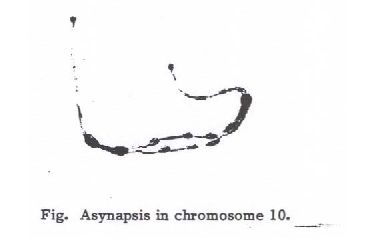Lesley, J. W., and M. M. Lesley Linkage of sh (sherry).
The flesh color mutant sherry (sh) originated from seeds of the variety Canary Export exposed to ionizing
radiation [Zscheile, F. P. and J. W. Lesley, J. Heredity 58 (4)]. Sherry (sh) is recessive and non-allelic to yellow flesh
(r) apricot (at) and tangerine (t). It is extremely unfruitful. From self pollination 10 fruitful plants were sh and 240
plants were unfruitful. In a backcross in a greenhouse in winter at Riverside, California, however, 16 were sh+ (red
fruited) and 18 were sh. As a rule sh plants differ from the parent variety in having almost entire leaflets (ent)
compared with the normal dissected condition, and in the frequent production of lateral shoots (lat) in young plants.
Also sh has fewer flowers and more locule in the ovary (Lesley, J. W. d M. M. Lesley, 1971 TGC Z 1). Sherry is
closely associated with ent and lat. In backcrosses of sh+ ent+ lat+/sh ent lat x sh ent lat, 18 sh+ plants had normal
leaflets and laterals, ent+ lat+, one was ent lat and one was ent+ lat. Twenty-five sh plants were ent lat, two were ent
lat+ and 123 were unfruitful. Recombination between sh and lat ent was 9 percent, apparently due to crossing over.
About 5 percent recombination occurred between lat and ent.
Based on the close association with sh, lat and ent were used as indicators of sh.
Virescent tangerine (tv) is an allele of tangerine flesh (t) in chromosome 10. Another allele at this locus was
recently reported (Kerr, E. A. 1979, TGC 29). Virescent tang rive s easily recognized in young seedlings. Three F2
families from the same P1 sh+ d sn tv x sh d+ sn+ t+ with sh and tv in repulsion (trans) contained 228 plants. Laterals
(lat) and the combination lat-ent were used as indicators of sh. By the Product Method, in all three families together
sh and tv are linked and 30 cM apart, assuming 3:1 ratios for tv and lat-ent (Table ). The difference in the cross over
values of lat tv and lat-ent-tv may be due to a difference in the map position of lat and ent. Supposing an increase in
the standard error of the linkage from 6 to 10 percent, linkage between sh and tv is 30 + 10 cM and is still significant.
Only the repulsion (trans) phase has been tested. As previously noted (Lesley, J. W. and M. M. Lesley, TGC 21,
1971), meiosis in the pollen mother cells of F1 sh+ x sh usually was normal with 12 pairs of chromosomes, but one
pair often had an unpaired region indicating an inversion in the heterochromatin of the long arm of chromosome 10
(Figure). The data suggest that sh is in chromosome 10 and that several closely linked loci were changed by the
ionizing radiation, possibly by an inversion.
Medina-Filho, H. P. Linkage of Aps-11, Mi and other markers on chromosome 6.
The possibility of using Aps-11 to screen for nematode
resistance (TGC 24:25; Act. Hort. 100, in press) has
stimulated further investigation on its relationship to other
genes of chromosome 6. A linkage test has been performed
using LA1178, a marker stock for the long arm of
chromosome 6. In addition to the morphological markers yv
coa c, this stock proved to carry Aps-1+ and Mi+ (nematode
susceptibility) thus being appropriate for linkage analysis in
crosses with Short Red Cherry H, a nematode resistant line
selected from VFNT Cherry by A. Millet. Since LA1178 is
hairless and devoid of anthocyanin (a-hl; chr. 11), the
segregations for these two loci were also recorded.
A test cross population of 1,143 plants was scored for
yv and genotyped for Aps-I. Among them, 517 plants were
also scored for coa c a and hl. Another sample consisting of 250 yv plants and 263 + was subjected to nematode
infestation and scared for resistance. Additional scoring for yv
No navigation control above? Click here!

